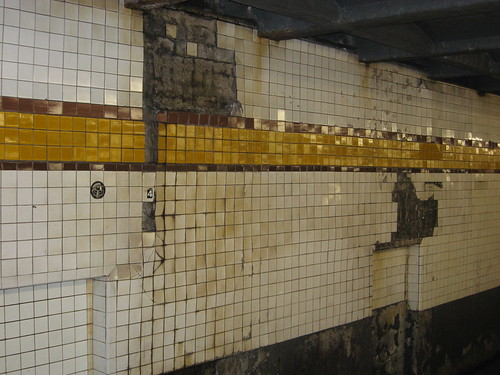The F’s Seventh Ave. stop in Brooklyn is just one of many stations in need of rehabilitation. (Photo by Benjamin Kabak)
Back in June, when the MTA announced $2.7 billion in capital construction costs, subway advocates around the city groaned. Among those cuts were plans to rehabilitate 19 stations in dire need of renovations, and it seemed like business as usual for the cash-starved MTA.
Well, look what happens in an election year. Patrick Arden of Metro New York reports today that the MTA has withdrawn the plans to cut $2.7 billion for its construction budget and may be amending and resubmitting the planned cuts. He reports:
The MTA withdrew a controversial plan to slash 15 percent from its current five-year capital program last week, just days before the proposal faced a state panel’s deadline.
“We were prepared to support the amendment,” said Long Island Republican John Flanagan, the state Senate’s rep on the MTA Capital Program Review Board. “But the Assembly had some major concerns.”
These concerns centered on $2.4 billion in cuts to city subway and bus programs, including the loss of rehabs to 19 stations. Overall, the $2.7 billion in MTA cuts were technically “deferred” into the next five-year capital program, yet funding for that plan remains uncertain. In shifting resources, the MTA had proposed several new projects to address subway flooding and overcrowding, altering subway vents and buying new cars. For now, those items are in limbo.
While Arden couldn’t get a hold of any Assembly members willing to dish, MTA spokesman Jeremy Soffin told the reporter, “We expect to resubmit the amendment.”
To me, this seems like a classic case of legislative cold feet. Faced with an upcoming election and recent attention to the state legislature’s unwillingness to fund the MTA as it should, Assembly representatives are asking the beleaguered transit agency to cut back on the cuts. If I were a betting man, I’d say that some of the 19 stations scheduled for rehabilitation will get that overhaul, but the Smith/9th Sts. stop probably won’t get the extensive face lift it needs.
I’m sure in a few days or weeks — once we have a better sense of the Ravitch proposals — the MTA will resubmit their plans for budget cuts, and I’m sure the Assembly won’t like it one bit. But until state leaders are willing to fund the MTA, this cat-and-mouse budget game will continue ad nauseum. And some people say history doesn’t repeat itself.


4 comments
Ah politics. They’ll put those cuts back in after the election.
I know I say this a lot here, but can someone please explain why the East Side Access project, for example, will cost $7 billion?
http://ny.metro.us/metro/local.....13548.html
A NY1 links from 2006 claims that 75,000 commuters will use this line daily.
http://www.ny1.com/Default.asp.....ArID=60962
That’s about $90,000 per head. More cost effective to fly them in by helicopter.
I can’t find an accounting of the absurd costs. Part of the tracks are already there! Am I the only person (continually) astounded by these numbers?
The various environmental impact statements are online, and they have a lot more detail about the costs. I assume you’ve read them. Most of the tracks did not exist when this project began. All that existed was a trackless tunnel under the East River. Both the Manhattan and Queens sides of the project require new construction, as well as a whole new level (a station within a station) at Grand Central. All of this is more complicated than you might think, because they have to work around and reconfigure, the existing infrastructure. When you say the costs are absurd, what are you comparing them to?
Boris, it will bring 75,000 commuters per DAY into Grand Central. You can’t just divide the benefit of one day of operation into the total cost of something that will be there for a century. That makes no sense.